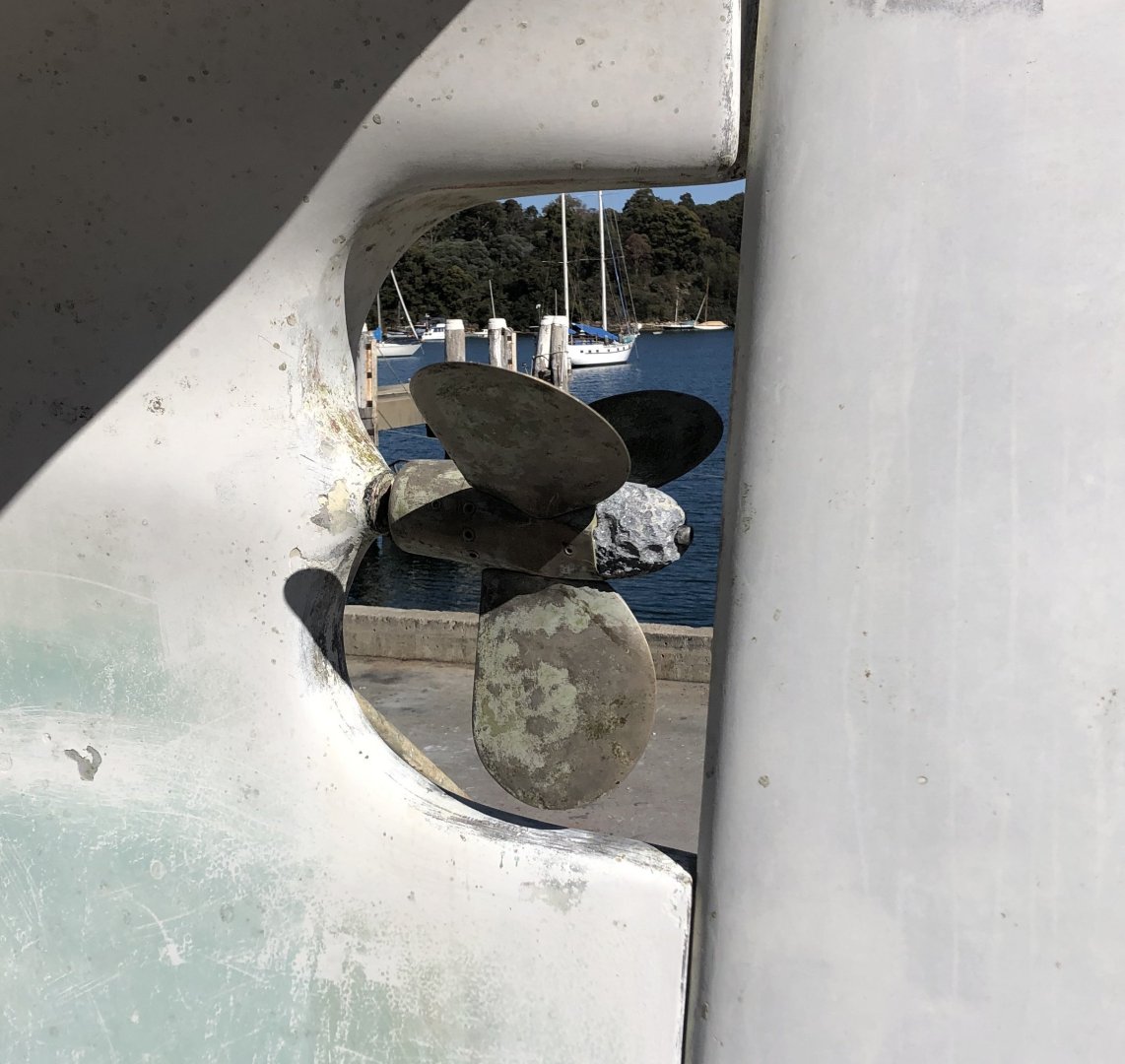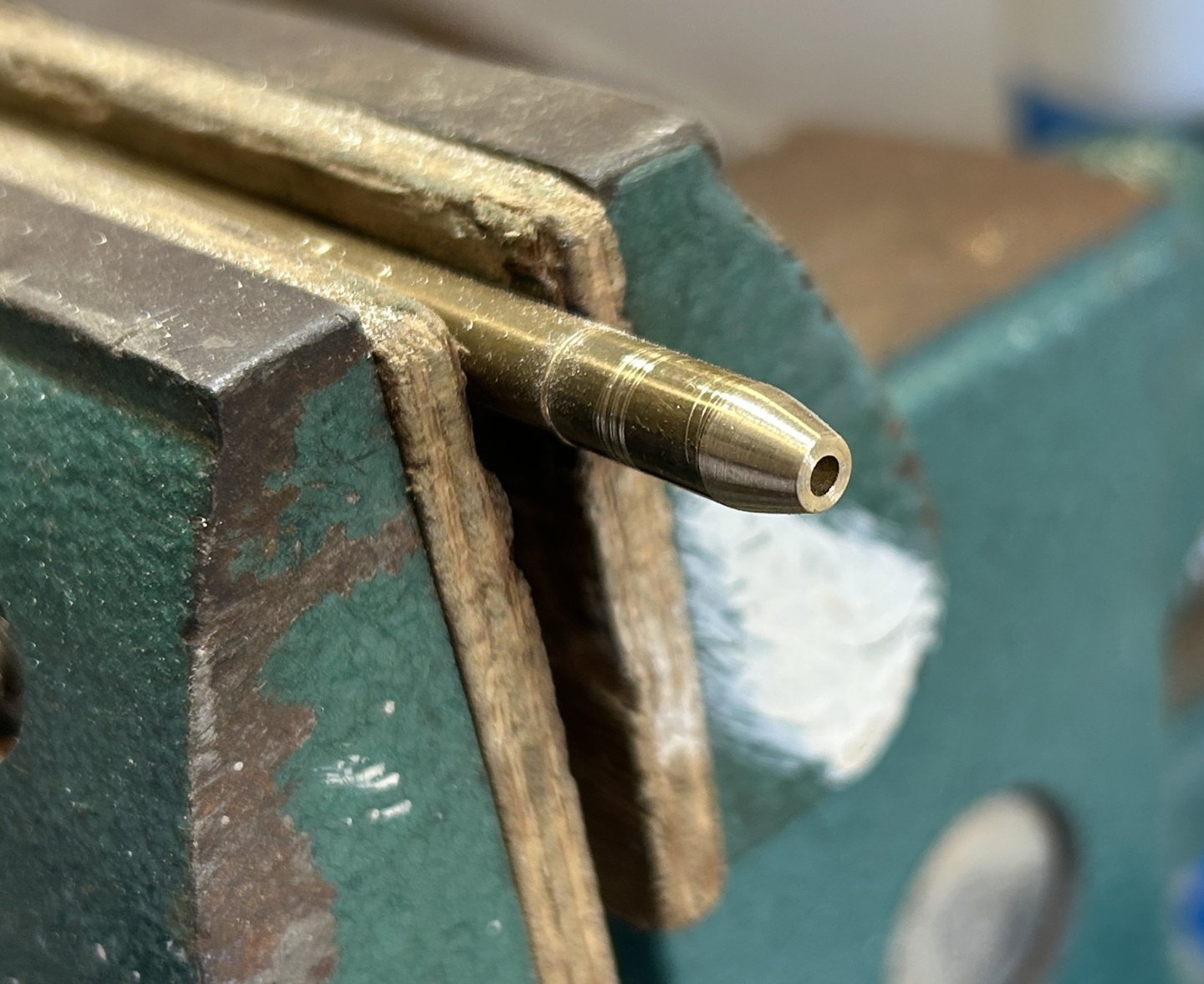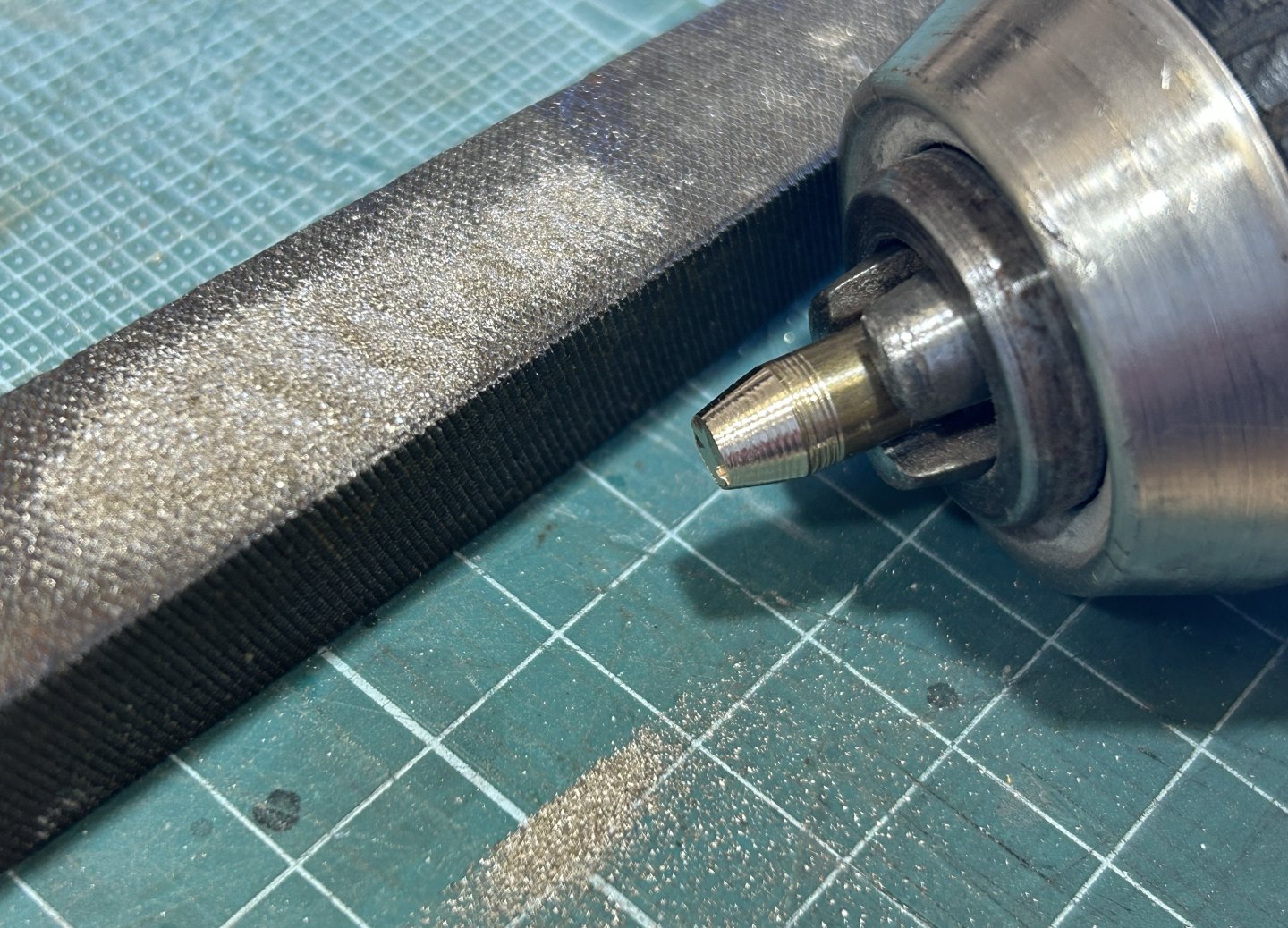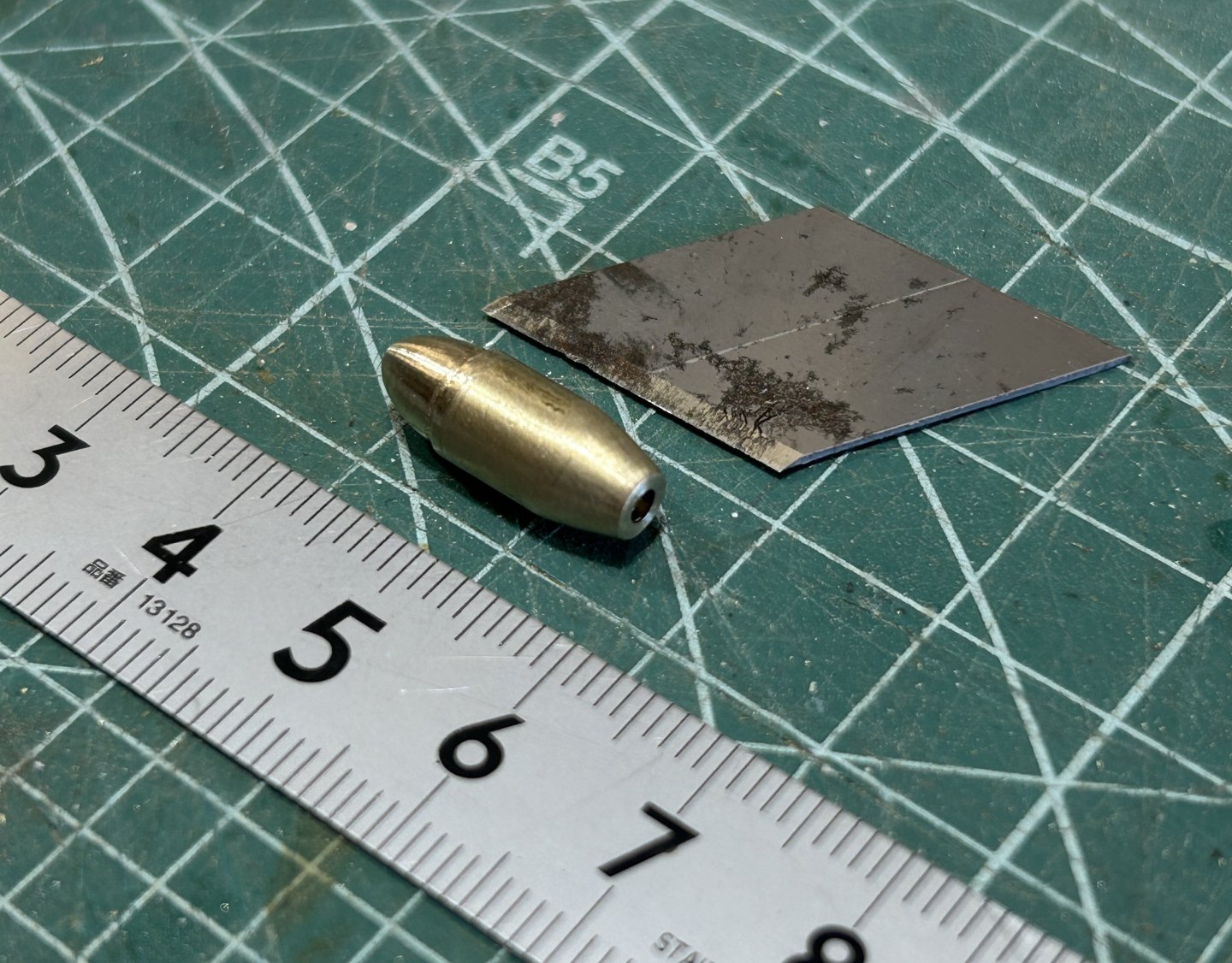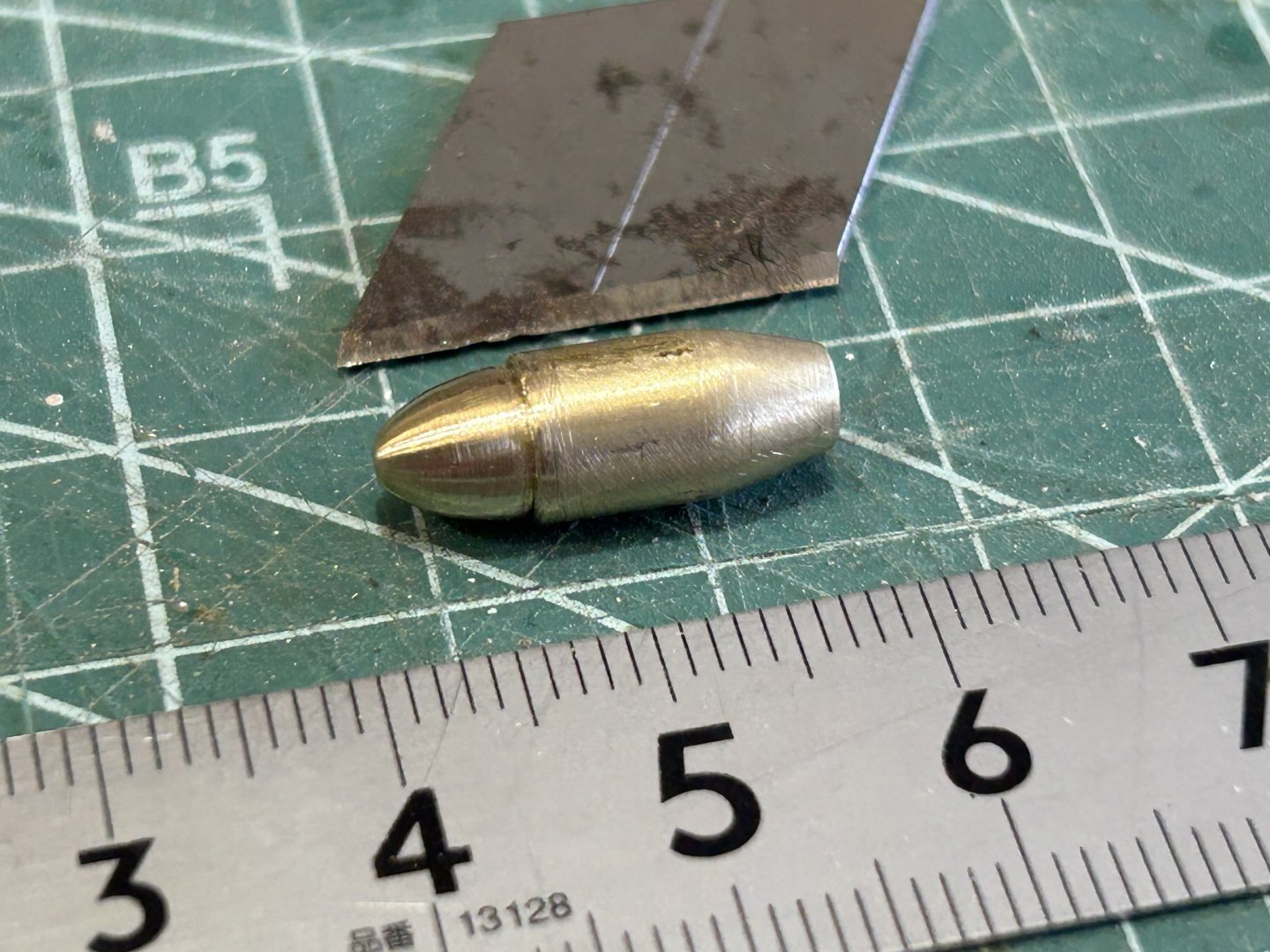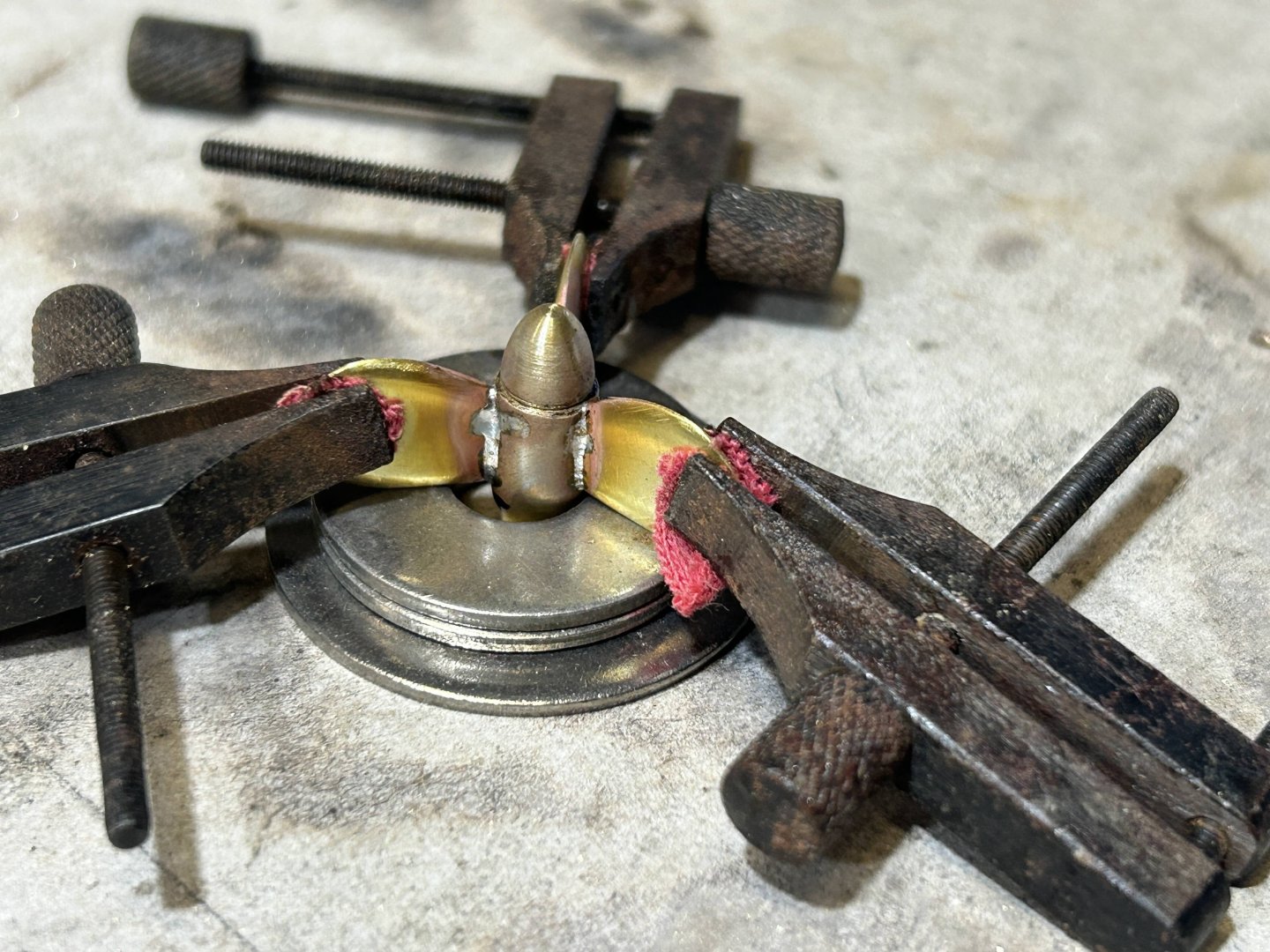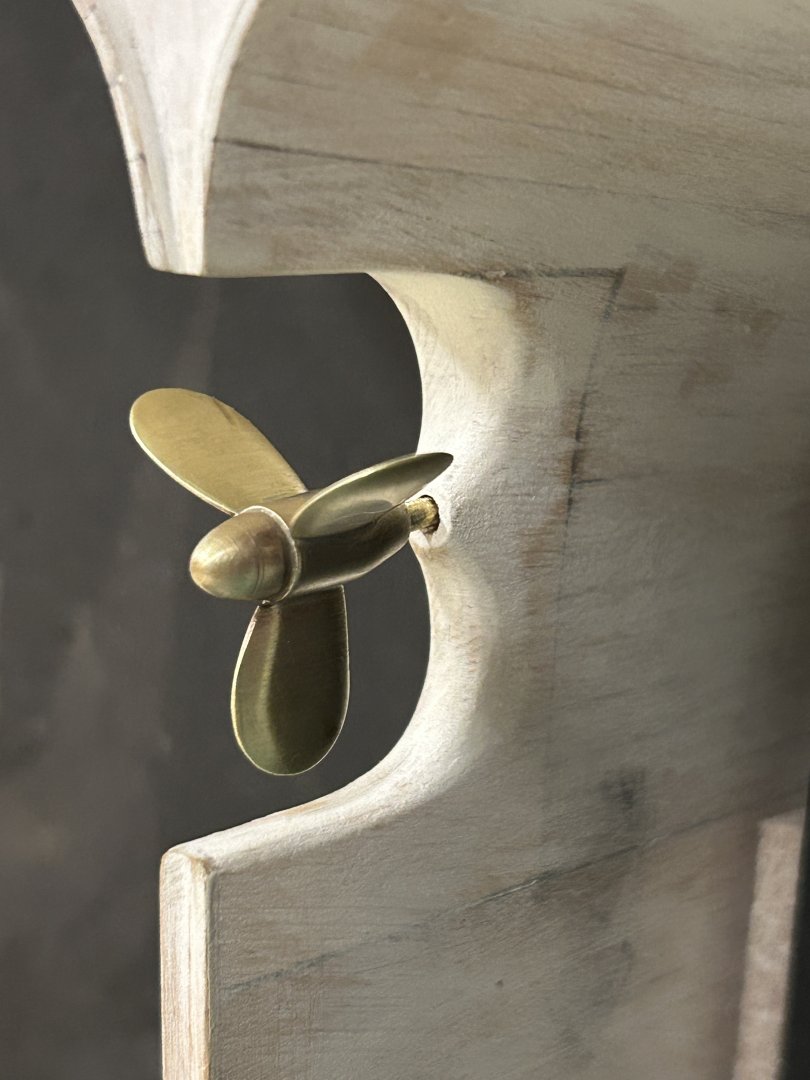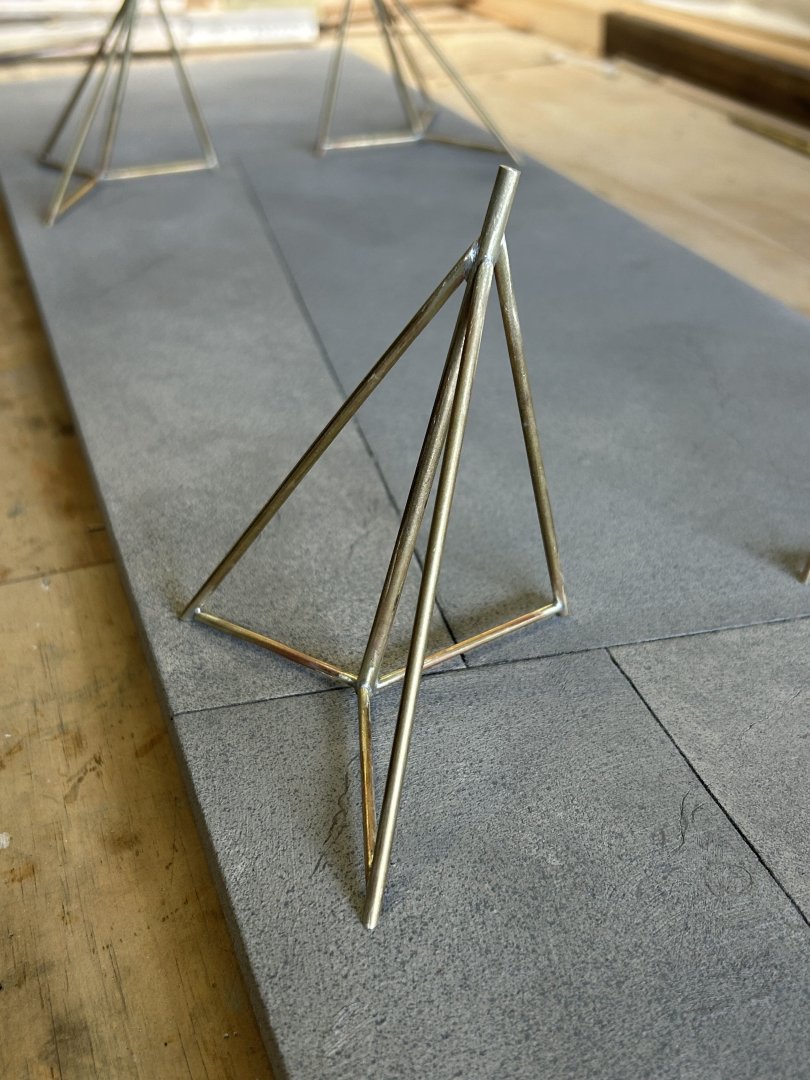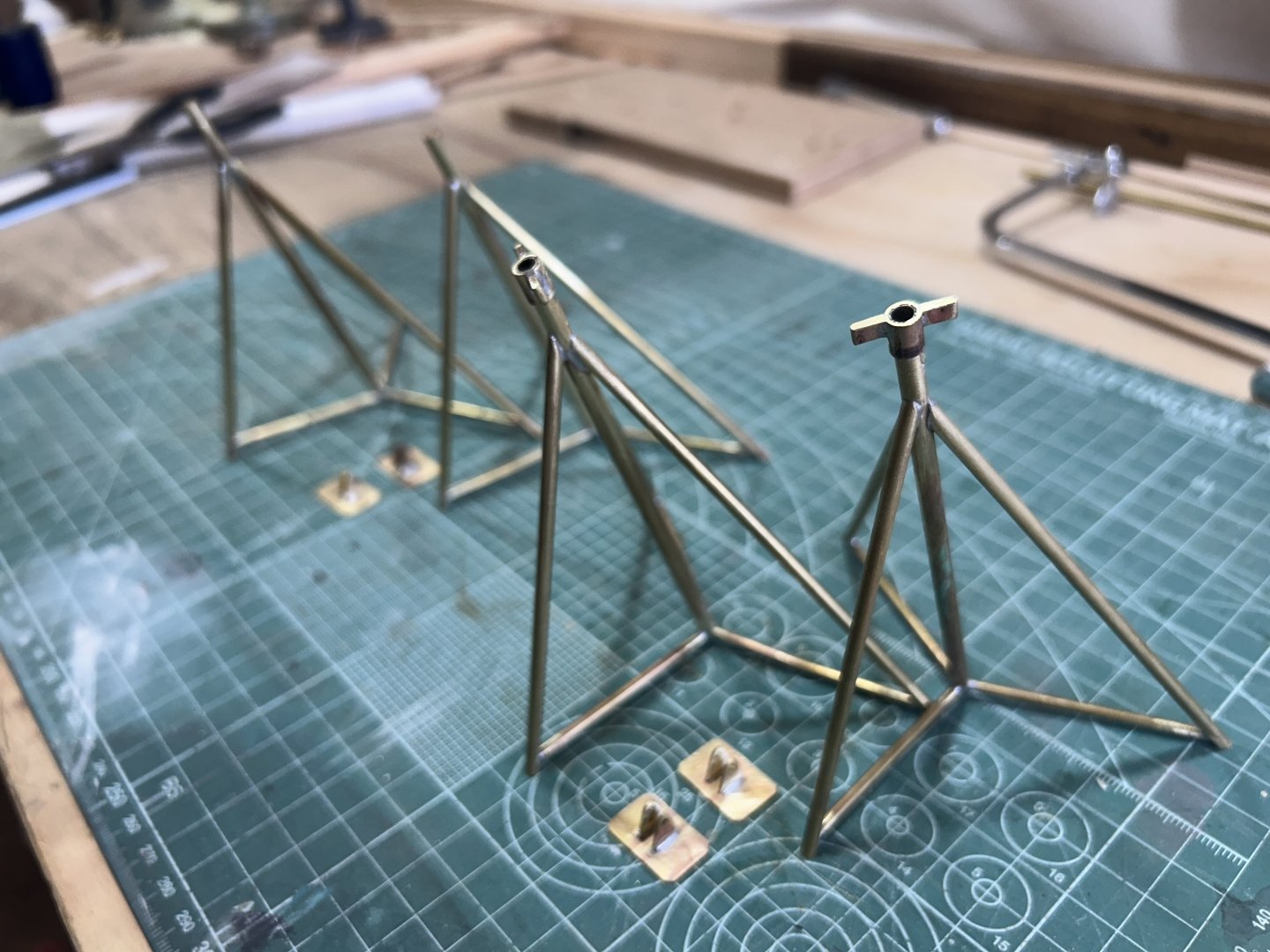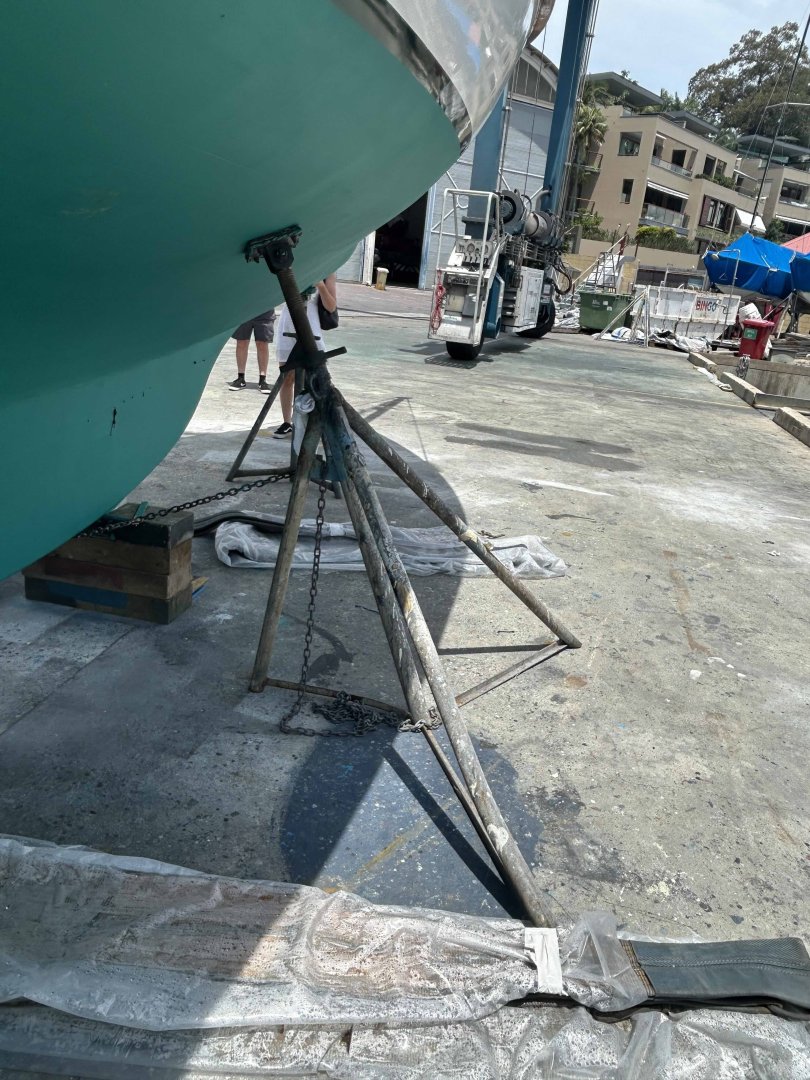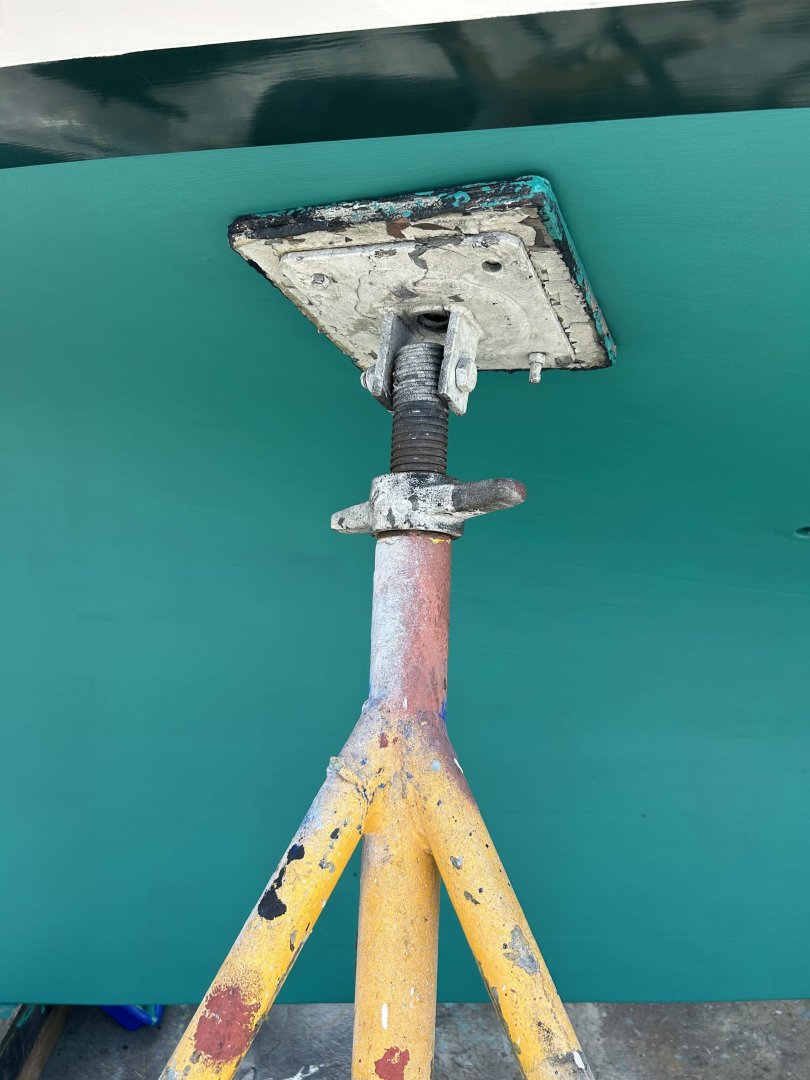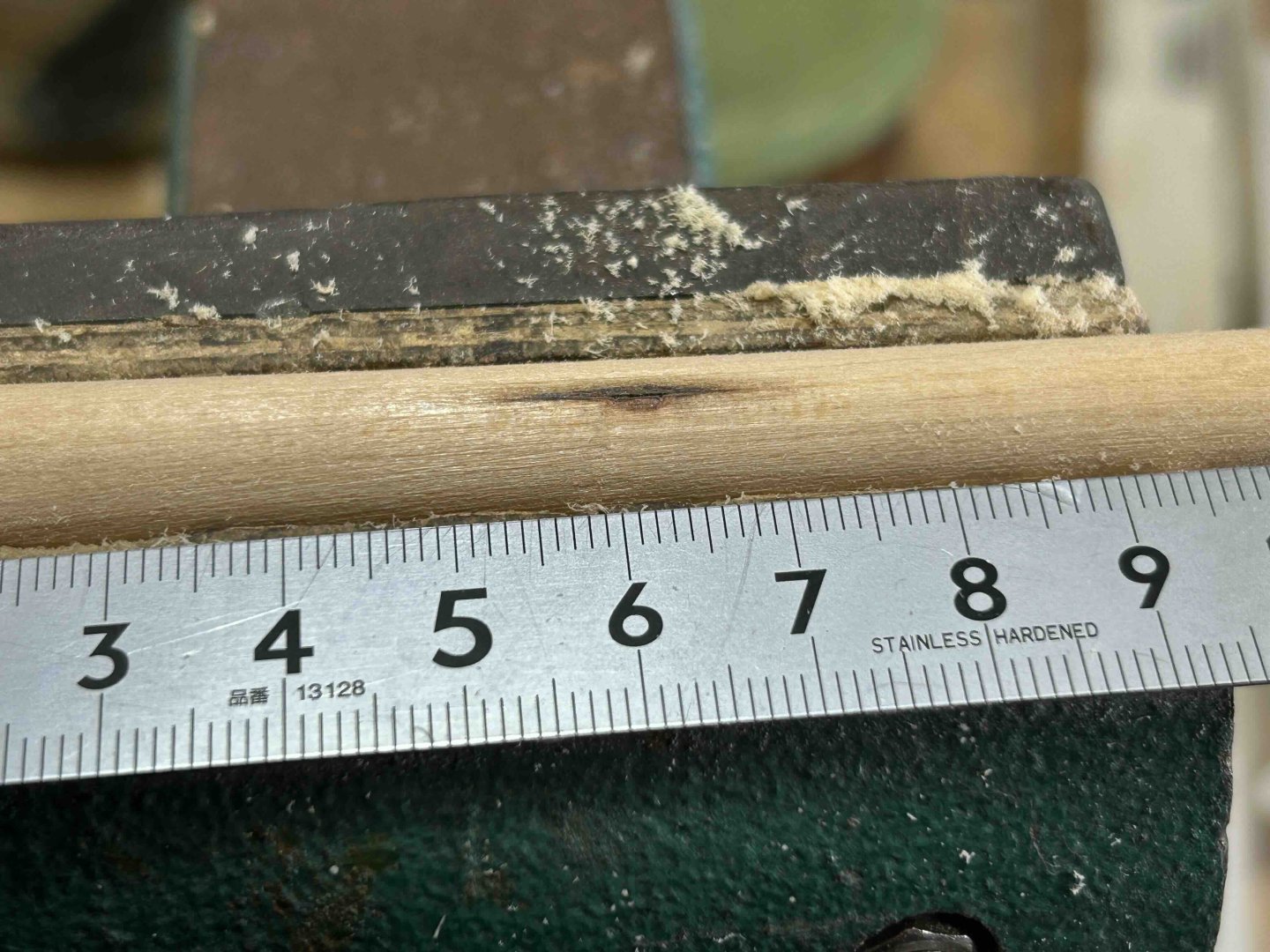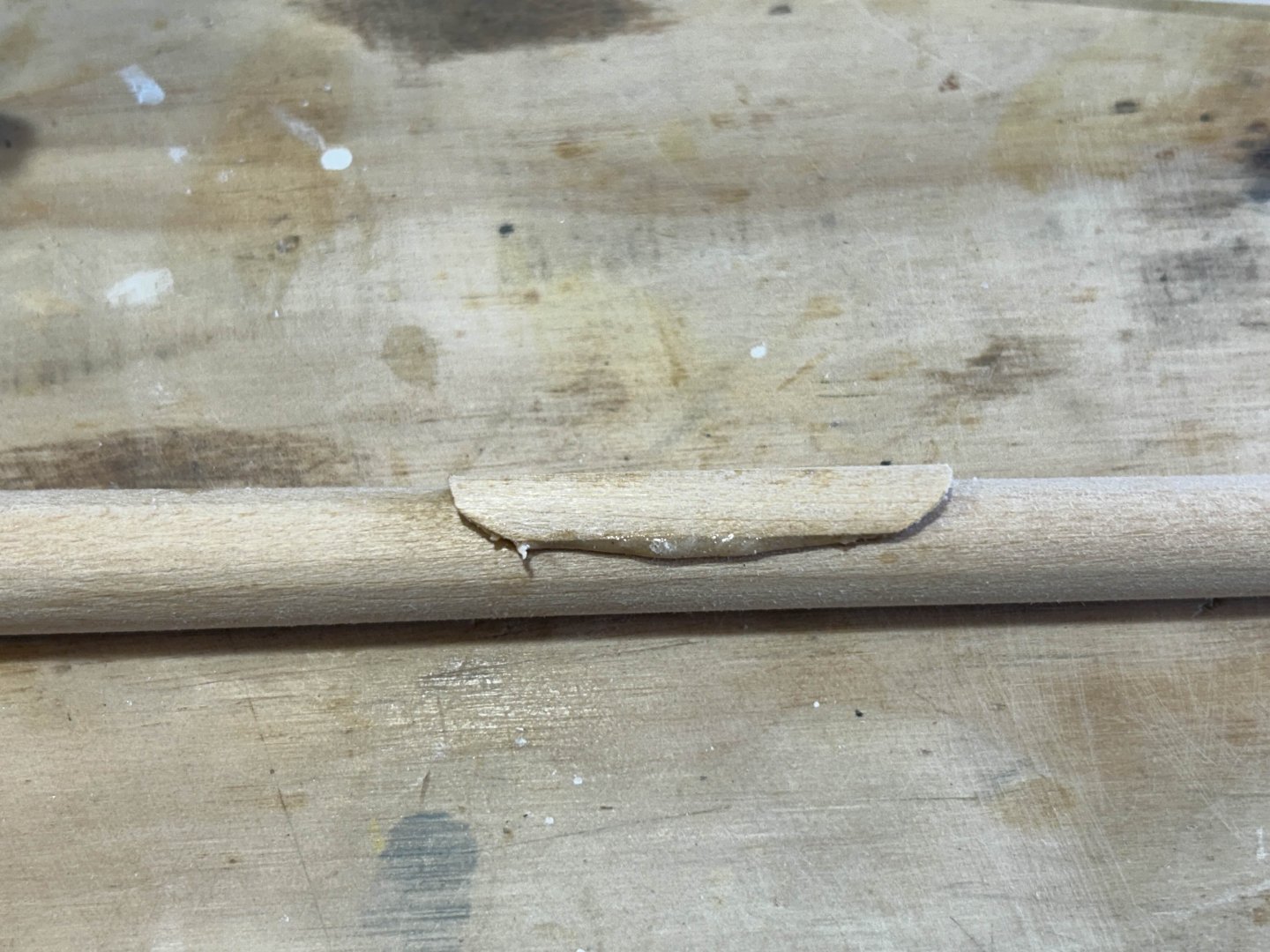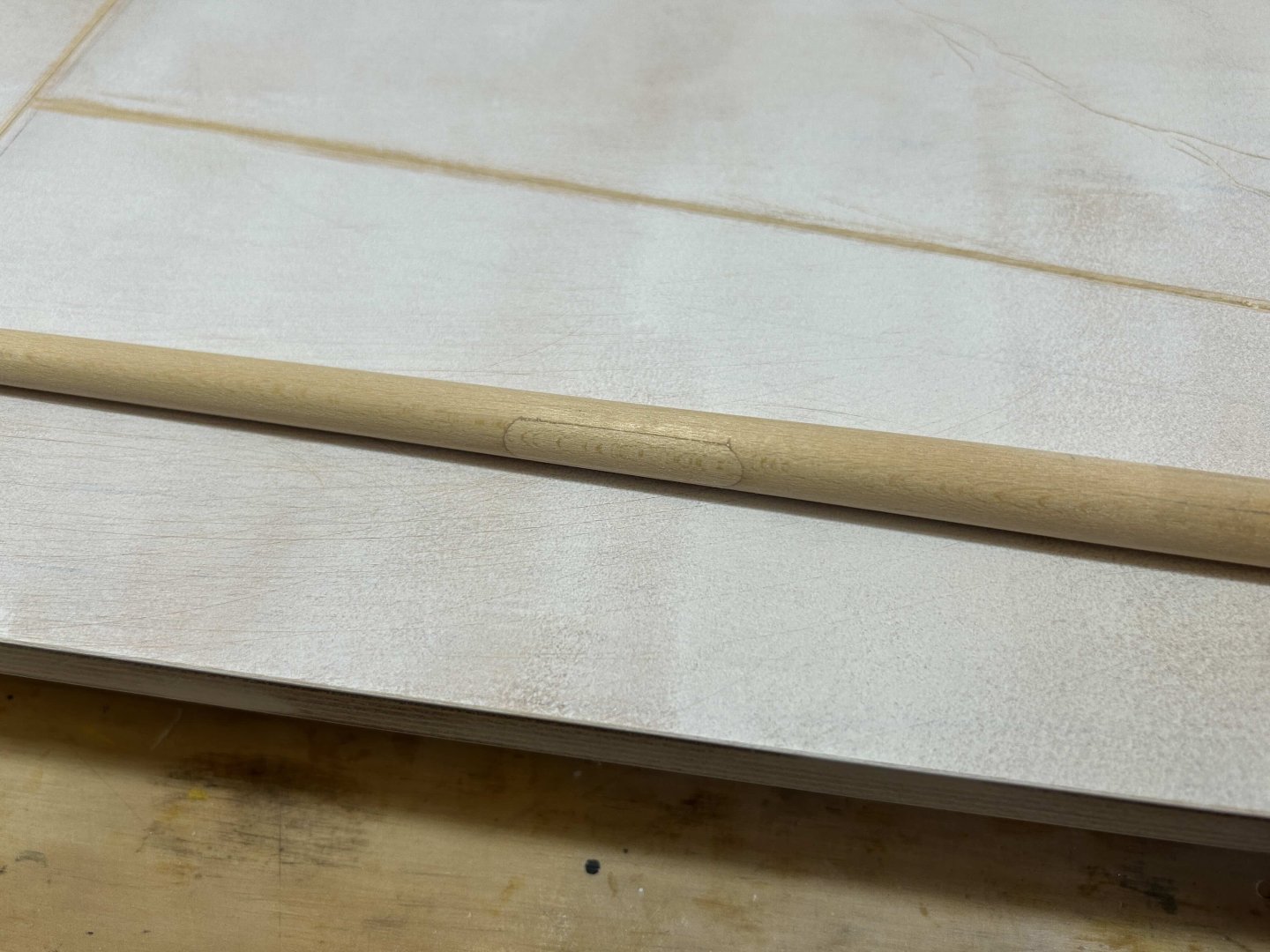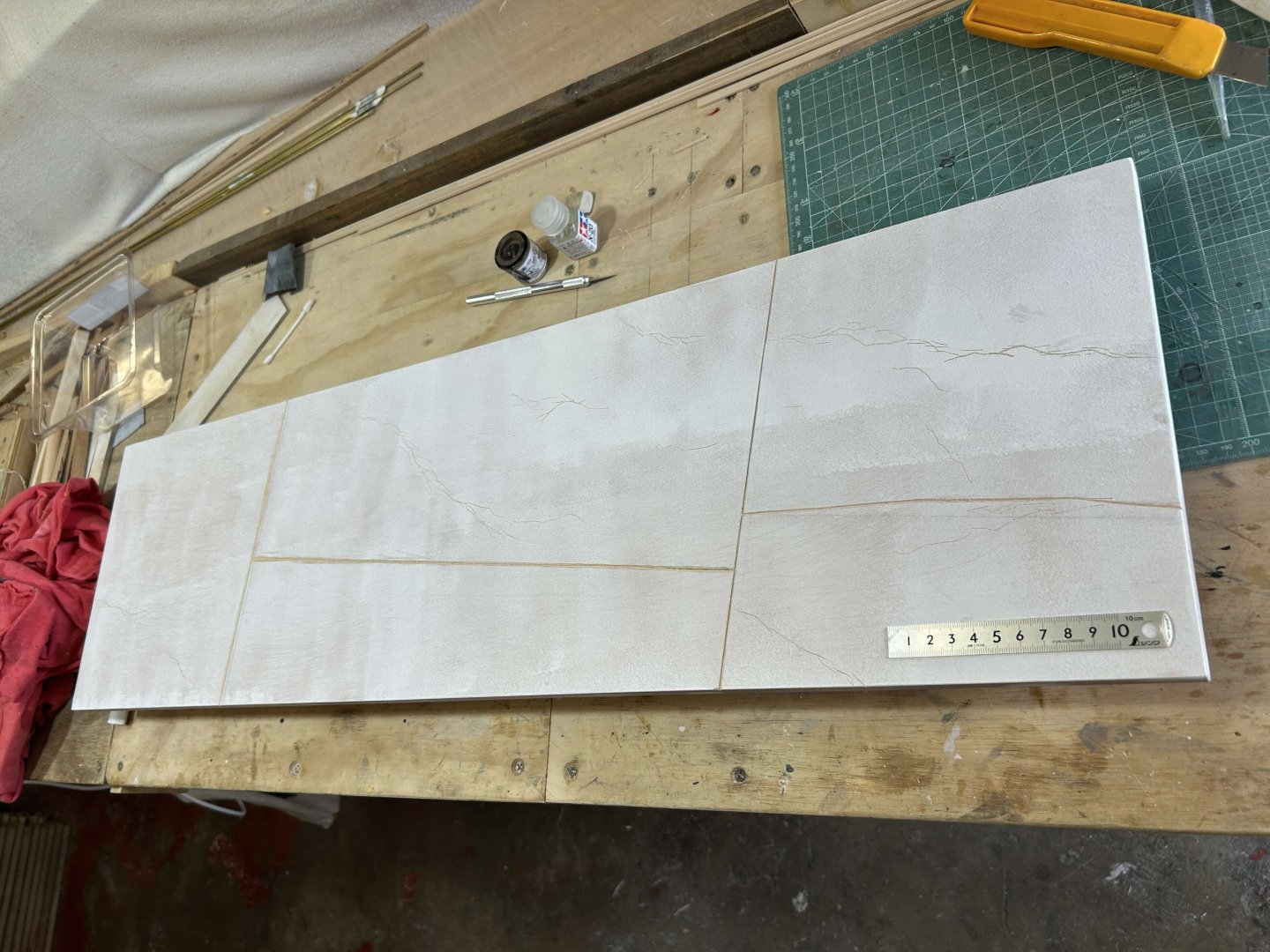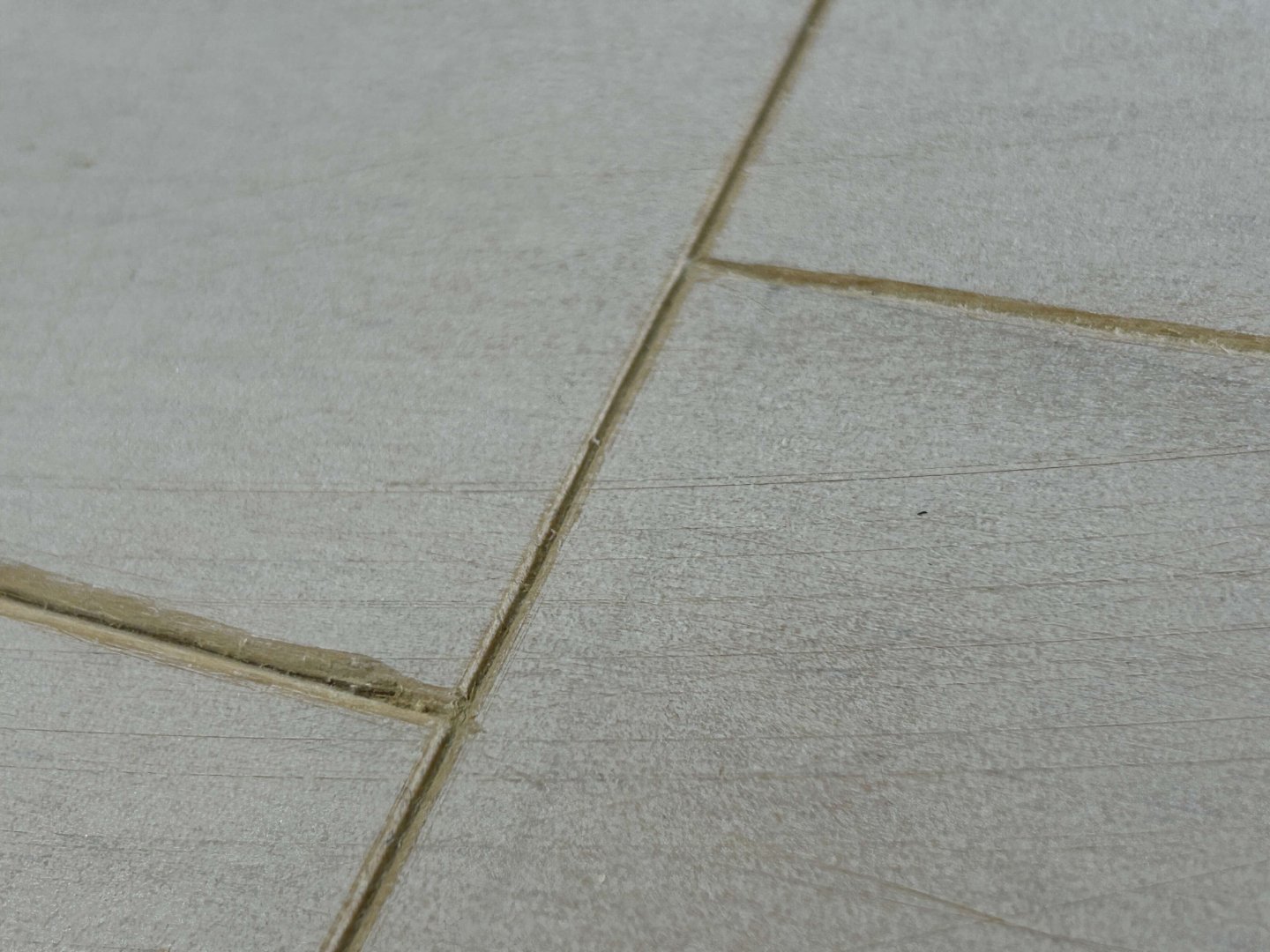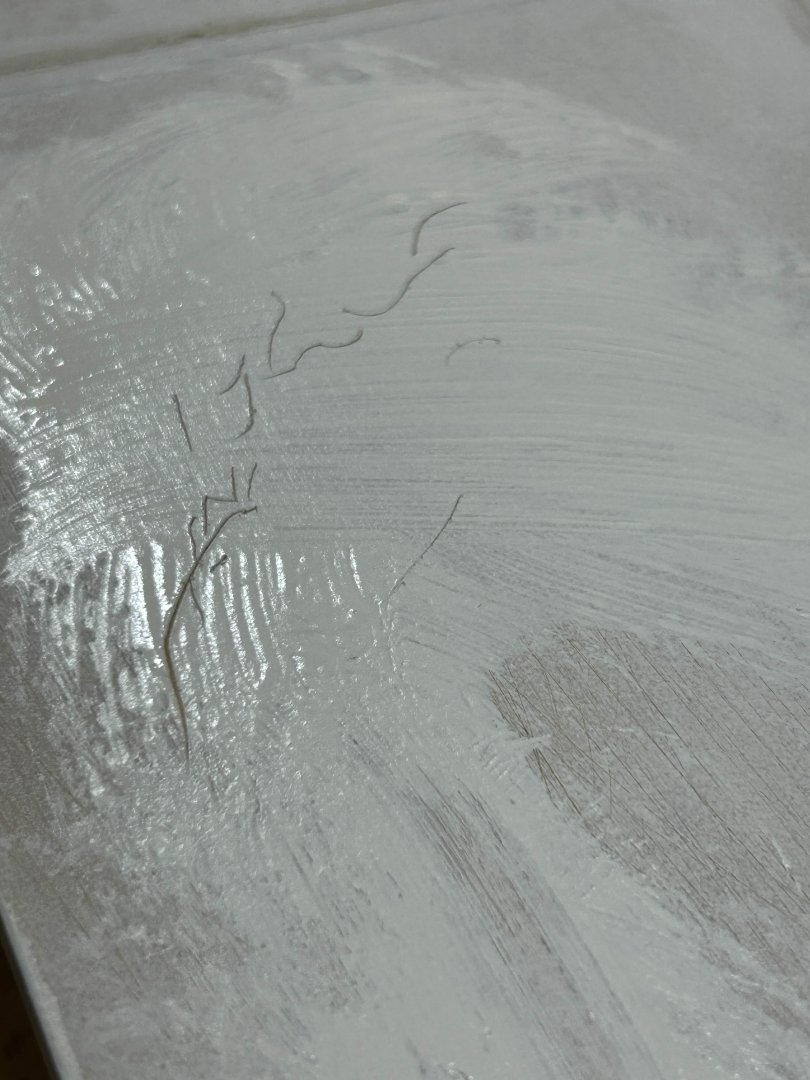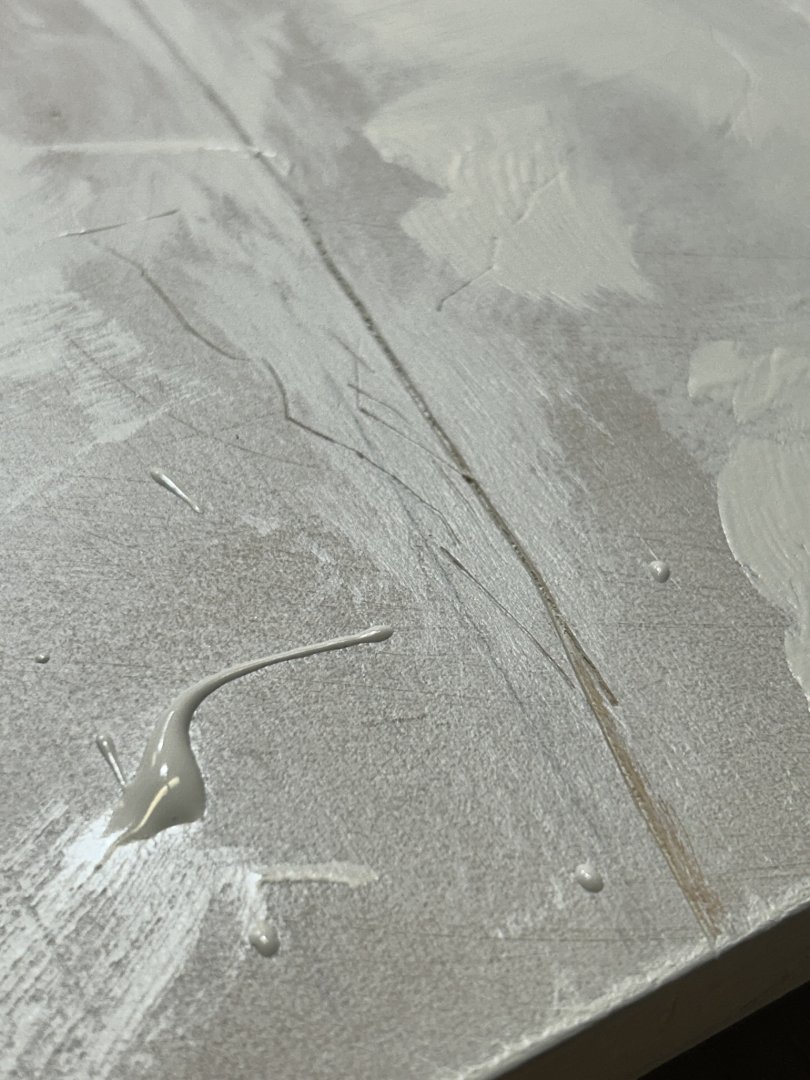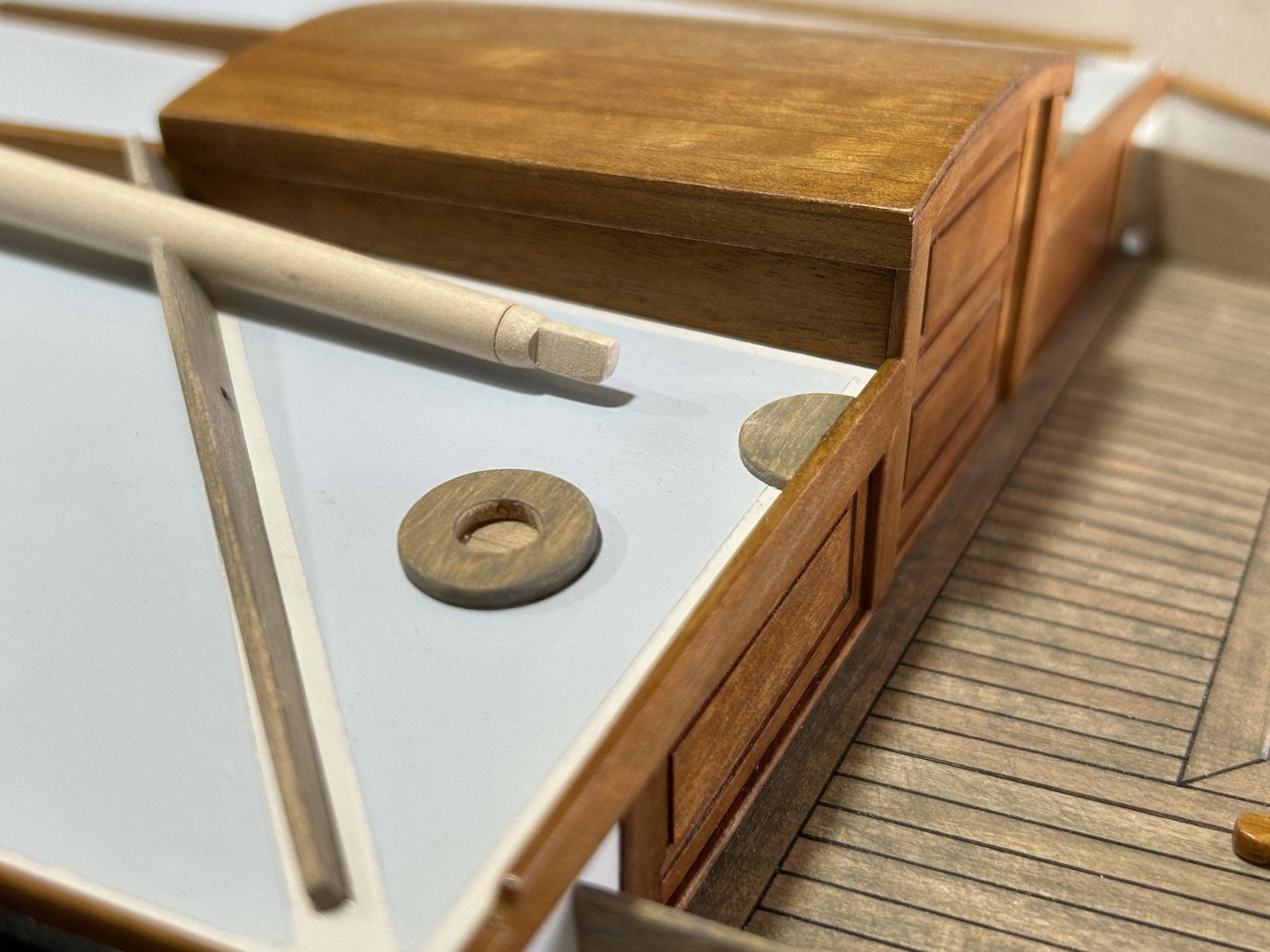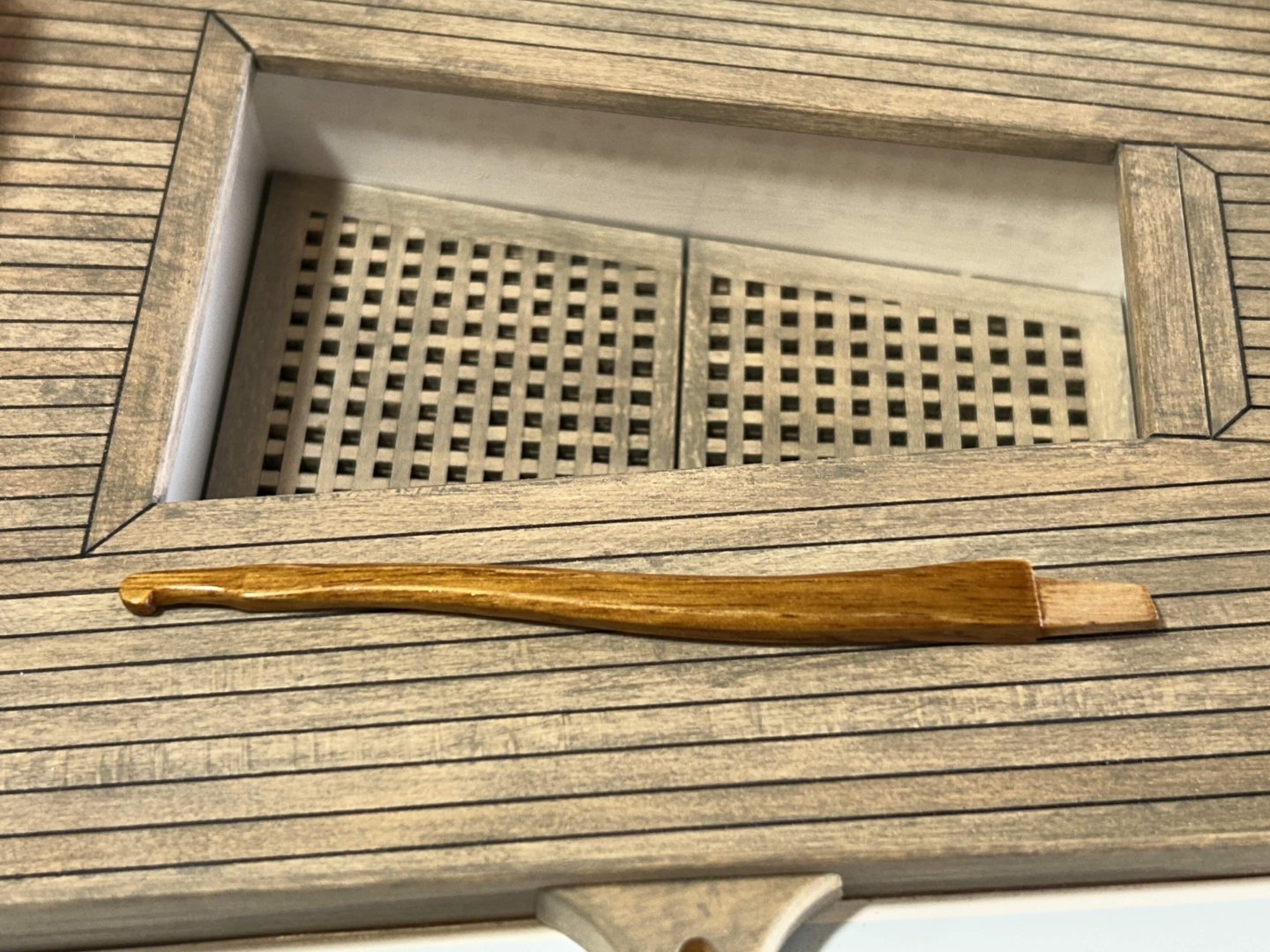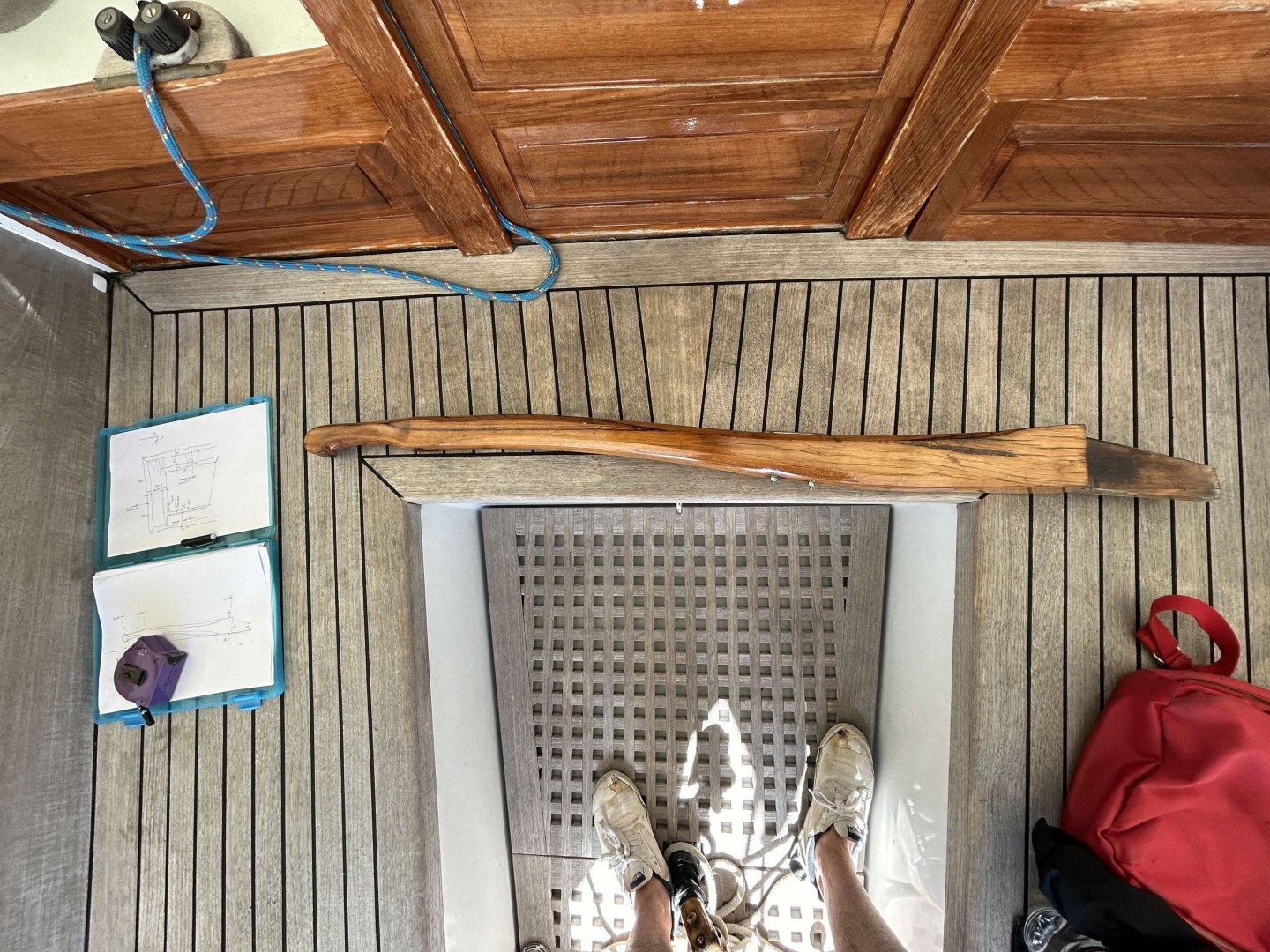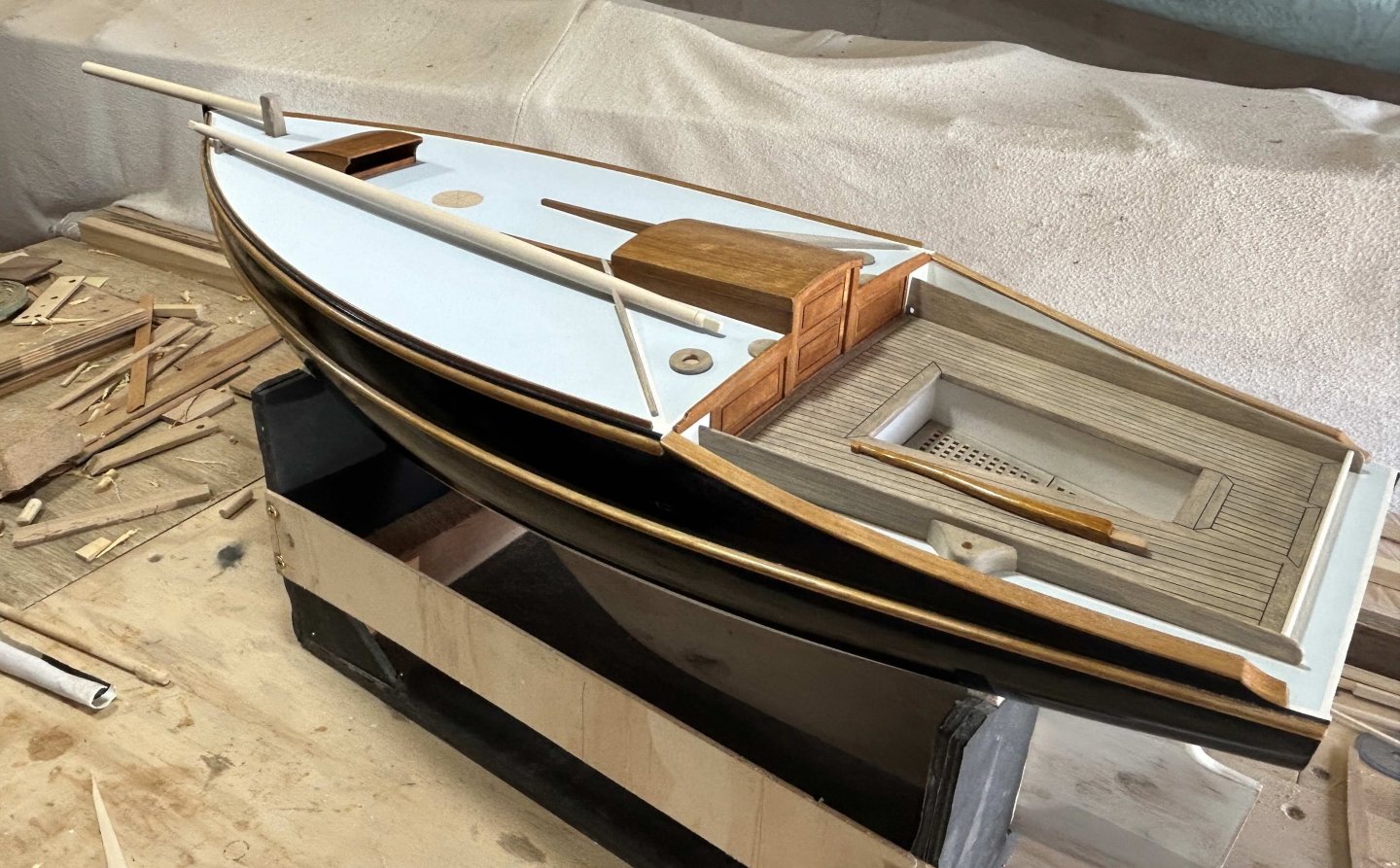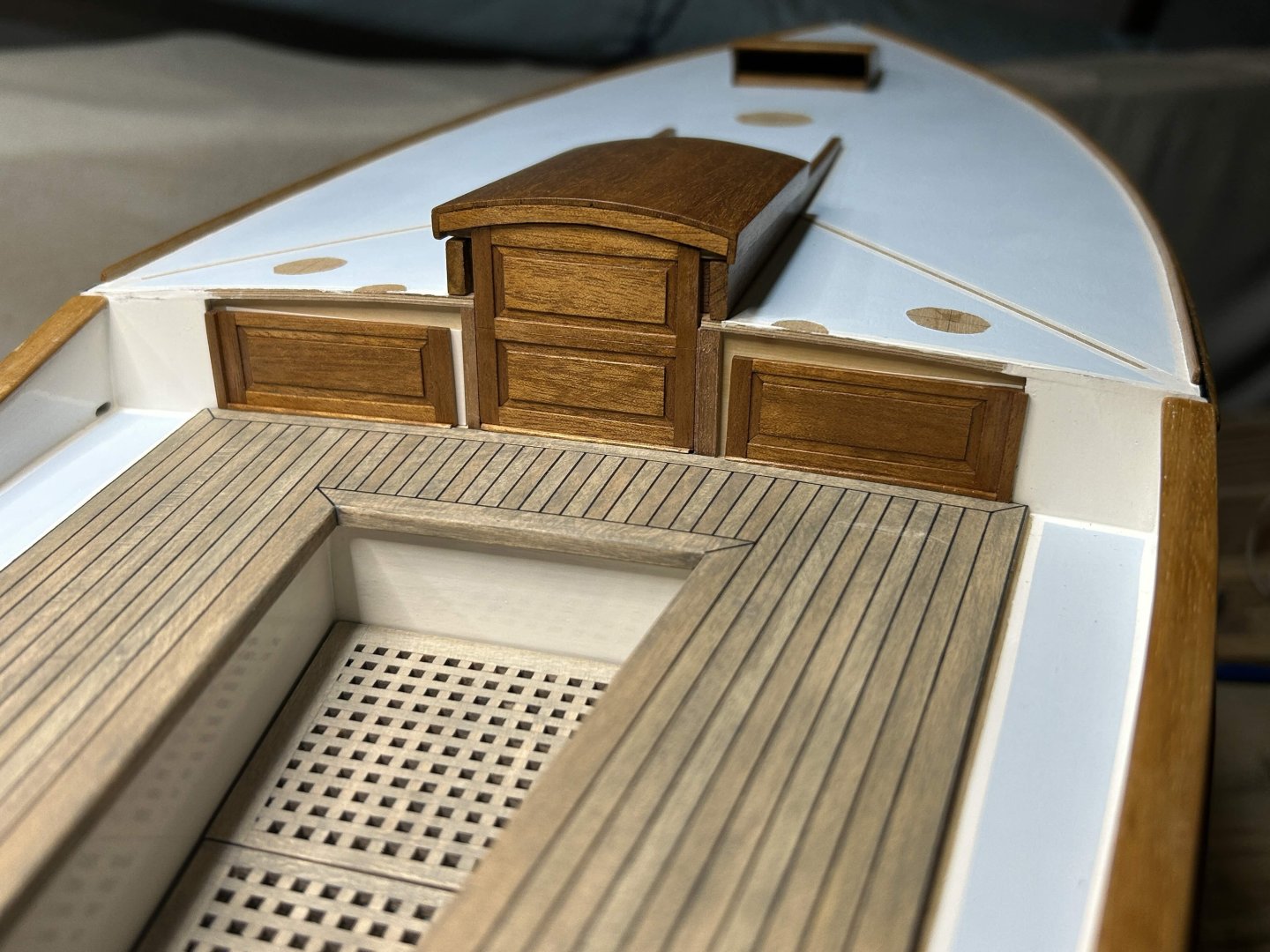-
Posts
812 -
Joined
-
Last visited
Content Type
Profiles
Forums
Gallery
Events
Everything posted by Mark Pearse
-
The propeller is a feathering one, & that makes it a bit easier to fabricate accurately, as the blades don't have twist. I think the way they work is that the prop shaft always turns the same direction, but when the engage reverse the blade angle rotates from the 'forwards' position to the 'reverse' position & so opposite thrust for same shaft rotation direction. Incredible pieces of engineering, if you ever get to see inside of one..... Here's the prop itself, with anode at the end & blades feathered: First, the main body of the prop is made from 6mm brass rod, drilled first to take the shaft & then tapered (bow end) by using a drill & rubbing the rod against a file, then sandpaper: The the anode shape was done, & the step using a broken piece of craft knife blade, against the spinning rod: The blades are from 1.5mm thick sheet, cut with a jewellers saw & the sanded to fine edges but full thickness where the blades meet the shaft. Soldered to the shaft: And cleaned up, & installed temporarily (nb: there will need to be a small washer where the shaft penetrates the keel).
-
Oh yes, & not only spattered, but dripped & drooled ......& of course if the stands are mucky with paint, the hardstand area must also be fouled. But, fun aside, it is important that the weathering doesn't overtake the model itself, so I'll err on the side of caution & take it a bit at a time - which in a way has already started with the grey overspray on the concrete. thanks everyone
-
Thanks all, As the base will be a scaled section of a boatyard hardstand area, the supports for the model will also replicate a type used at a boatyard. The model hull supports will be 4 of the pedestal supports, & under the keel will be some blocks of timber. This photo shows the supports I'm making, the original yellow is just visible below the accretion of paint on this one: And the swivel head fitting: Mine are from brass solid rod, 2.5, 3 & 4mm diameter. The actual ones are pretty rough, so the workmanship on mine is a bit rough as well. The solder looks a bit like thick, unground welds, so I left some thick solder on the joints. The angled struts are also drilled on the underside of the feet, & perpendicular to the base, so I can glue or solder some 1.5mm rods into the base to make sure they all stay securely fixed to the base. Seen here in approximate position: And here, with the adjustment fitting....and I just realised I need to do the flat plate cleats that take the chains, see the first photo above. You can also see the swivel head piece (below). I'm waiting on some 3mm brass threaded rod to complete them. There will be some fun with paint to come...
-
The base has been developing slowly in concept & the base itself. AS per previous posts, the plan is to replicate section of boatyard hardstand concrete, & concrete always has seams for expansion & contraction, with black flexible stuff in it. I replicated the seams by cutting a shallow V from both sides with a knife, with a separation at the bottom if around 0.5 -1mm (x12 for actual size). As the concrete work would have been a bit rough, I allowed variation & one of them isn't straight. The paint is mineral paint, very flat finish & slightly rough. I adjusted the colour, as the concrete would probably have been poured in different batches, & at different times possibly - so the colour isn't the same. The grooves defining the joints were painted with some diluted dark grey paint, & the same dark grey was used to highlight the cracks in the concrete. Then a dusting from some col galvanising spray paint I had sitting there... Below is painted with grey, but before the dark grey highlights. Highlighted & dusted, 3 photos below. There will be some spilled paint, oversprays of antifoam, topsides paint, rust stains....all yet to come. But for now I think it's looking ok, certainly it's looking somewhat like concrete. The dark speckles look a bit like the gravel in concrete & help to unify the effect, it was looking a bit patchwork until then.
-
Thanks John, & best wishes. I'll put a coat of shellac on the mast soon & we'll see if the glue joint is less visible. I'm starting on the metalwork, beginning with some easier stuff, which reminded me of some techniques, the main one being: capillary action will flow the solder provided there's sufficient heat where you want it to flow to. The four jib tracks are done, & I just had enough of the smaller sections of brass for these. I'm still confounded by the changes in the K&S range, to drop out so many smaller sections. The base part of the tracks was thinned a bit by sanding them - they are still a bit thick but look ok. I'll probably give them another sand later.... The subtle line down the centre lengthways is on most metal jib tracks, & I put it on as one of the "delicate" details. I think that if you include a few of these in a model it can give an overall effect that you think there's more detail than there actually is. More cleaning up later & then the tinning finish (thanks again Wefalck).
-
I've started on the model base, as it will take some time so I'll start now & do concurrent with the model itself. The mast timber had a dark stain, possibly ok, but I decided to patch, using the same technique I'd use for full size. The glue is visible, but I think it will reduce when the shellac finish goes on. The base will be a scale section of a concrete hardstand area of a boat yard, so stains etc. The overall base is plywood, treated with thinned epoxy to help reduce warping, then undercoated, sanded etc. The lines are joints in the concrete, & there will of course be cracks. And .... getting a but arty ... some thick undercoat with a spike to do more cracking. And some random blobs of undercoat. I'm looking at mineral paint for the concrete, it's interesting stuff - but importantly the finish is flat & hard. And I think a good base for weathering, if I can find a colour I'm happy with. thanks,
-
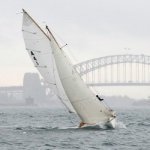
Brass stock in small sections....?
Mark Pearse replied to Mark Pearse's topic in Metal Work, Soldering and Metal Fittings
what sort of saw blade is used for cutting brass? -
Hi John yes I did, & got some brass flat strips from them - at 6mm or 1/4 width. I can use a sanding block to reduce a small amount of that, to say 5 or 4mm width. As a follow-up, I did get some brass square C channel via eBay (3 x 1mm, 300 long) by Albion Alloys UK, the shipping hurt but I'll recover......
-
The strips I'm after are in the width range 2-6mm, & thickness range 0.5-1mm. It's very surprising, as you'd think these would be used a hell of a lot. I dug out every scrap I could find & in most cases I can make the scraps work: for jib tracks, chain plates etc. I was going to use some 3 x 1mm squared C channel as a mast track, but that's not available from K&S, I found a seller of Albion Alloys (UK), but the cost of shipping makes it v expensive. I'll try eBay I suppose,
-

Brass stock in small sections....?
Mark Pearse replied to Mark Pearse's topic in Metal Work, Soldering and Metal Fittings
Thank you all for the responses. K & S don't seem to have any rectangular strips (aka flat bar) narrower than 1/4". I believe I was looking at their store website. And thanks also for the guillotine suggestion, I hadn't realised that can work. I went right to the bottom of the scraps box & I can largely work with what I have in bits & pieces, except for the square C channel 3 x 1mm nom. I'll think about some alternatives, including eBay. -
Hi Vaddoc If there's a conflict in the information, the approach I take is to work out which aspect of the information to give priority to & which one to adjust. In the case of a conflict between the hull shape & the profile of the stem, I would likely prioritise the hull shape & allow the stem profile to adjust. (The stem profile will still be close, as unless there's an error the amount of adjustment should be minor). I encourage you to be decisive on this sort of choice....what would a boat builder do....? I would add that in some respects CAD is a double-edged sword. Its precision can make it look like the situation is worse than it really is. If we were still working with pencils, a lot of conflicts would be within the thickness of a line, or within the manual tolerances of draughting.
-
One detail that had been bothering me was the winches I purchased, for the running backstays & the mast halyards - nice but technically not very good. Steve from this forum (Bedford) kindly offered to assist & turned up some flanges perfectly to size, the difference is wonderful. They will be soldered together & tinned (thank you Welfack) the winches before: and after (now that's a winch): happy days....
-
Hi Patrick I'm curious - the leeboards are massive, & unless I'm missing something the plate behind that supports them isn't very large & is only at the top - so the leverage on the top part of the board & the mechanism, at times, must be huge. It just looks quite surprising that this amount of structure & support is enough.... Any reflections of yours on this would be interesting to hear. thanks,
- 60 replies
-
- Corel
- Große Jacht
-
(and 1 more)
Tagged with:
-
Some more details on the boil: The tiller is underway, & either finished or nearly there. Possibly another coat or two of shellac, the actual tiller is an aged piece of hardwood, so would be good to give it some of that character. The bowsprit & spinnaker pole are underway, here they are tapered & cut to length: I will do the pole, including end fittings primarily in timber. The actual pole is unfinished carbon fibre , so satin black, & the ends unfinished cast alloy of some sort. The basic details of the end fittings are roughed out, & since the photos the ends were treated with some CA glue to harden the timber & avoid splitting when cutting the beaks. To replicate carbon fibre, I rubbed the pole with black paint, with no undercoat. It's looking ok, so a gentle sand & another coat might do the trick. To help articulate the joint at the end fittings of the pole, I did a groove by rolling the pole under the blade of a craft knife, they have a nice straight long blade.
-
Thanks all, & Welfack: a big thank you for this suggestion. I'll investigate & do some tests. I assume it needs to go onto metal as a base? (I purchased some small brass winches off the shelf, & on the smaller ones I'd like to add a base, as most contemporary winches have a base flange that is around 25-30mm thick - so my plan was to add a round disc to the bottom from 2 or 3mm thick acrylic).
-
Thank you Steve & welcome Welfack, & hi to everyone - I've now almost completed the timber work, & apart from the spars just the tiller remains to be done now. Then I'll work on the spars & metalwork. This boat has stainless steel fittings, so I'll be painting the metalwork silver. This recent work includes deck & cockpit timber details, all unfinished (weathered) teak. The bases for the cockpit winches, which are used mainly for the running backstays. The deck cutwaters, deck winch bases & a small base for a cam cleat fitting - that are all alongside the main hatch. And the large cutaway on the port side cutwater is a support for the spinnaker pole. The Sampson post & the forwards support chock for the spinnaker pole. The sampson post isn't fixed down yet, there will be a mortise for the bowsprit, to be cut into the forward side face. And the port side cutwater. The small holes are for the lines that lead to the cam cleats: spinnaker topping lift one side & spinnaker pole kicker the other. I'm not sure what the 3rd one is, but will find out. They were tricky to drill due to the angles & the fact that regular drill bits down't work well at angles, especially if it's a small hand drill. What I did was: to initially drill the holes & then put CA glue on it all to harden the timber up, drill right through & CA to the hole...then when hard clean it all up. I also found that a 1mm wide strip of sandpaper was quite a useful way to sand inside the angled holes. thanks,
-
Thank you everyone, I'm now back from a Nordic trip in the northern hemisphere summer, & have now finished & assembled more of the details around the cockpit & face of the raised deck. The horizontal varnished trimming pieces both sides of the companionway, which insect with a vertical varnished piece each side; & the weathered teak cockpit seat backrests. Overall view: Detail, & I can see the pencil alignment mark needs to be removed: The junction of the strips was difficult to get, but happy with this: Detail, showing the drain openings & another pencil mark to be removed... Trimming piece, against the deck. thanks for looking in,
-
Since the last post, the cockpit sole was given the weathering treatment. The seat backrests are made but won't go on yet as they will restrict access for other pieces. A feature of these yachts is the varnished removable hatches either side of the companionway storm boards, & other varnished details. They are a really nice part of the cockpit area & of course will draw the eye to them on the model. So, with some hesitation I started fitting these pieces, after varnishing them (shellac, to a satin finish). The deck also got painted, matt blue with gloss white edges. On the photo below, cover strips & edge details are still to be added. This photo to show the finish, & the nice glow of the timber (Queensland Maple on the model, Teak on the yacht). And the fore hatch also:
About us
Modelshipworld - Advancing Ship Modeling through Research
SSL Secured
Your security is important for us so this Website is SSL-Secured
NRG Mailing Address
Nautical Research Guild
237 South Lincoln Street
Westmont IL, 60559-1917
Model Ship World ® and the MSW logo are Registered Trademarks, and belong to the Nautical Research Guild (United States Patent and Trademark Office: No. 6,929,264 & No. 6,929,274, registered Dec. 20, 2022)
Helpful Links
About the NRG
If you enjoy building ship models that are historically accurate as well as beautiful, then The Nautical Research Guild (NRG) is just right for you.
The Guild is a non-profit educational organization whose mission is to “Advance Ship Modeling Through Research”. We provide support to our members in their efforts to raise the quality of their model ships.
The Nautical Research Guild has published our world-renowned quarterly magazine, The Nautical Research Journal, since 1955. The pages of the Journal are full of articles by accomplished ship modelers who show you how they create those exquisite details on their models, and by maritime historians who show you the correct details to build. The Journal is available in both print and digital editions. Go to the NRG web site (www.thenrg.org) to download a complimentary digital copy of the Journal. The NRG also publishes plan sets, books and compilations of back issues of the Journal and the former Ships in Scale and Model Ship Builder magazines.


